Let’s face it: getting your customers to complete email surveys can feel like a herculean task. You dream of insights, actionable data, and so much more.
But reality? Empty response inbox. Emails bouncing. Tools with overpriced subscriptions and hidden fees.
Now, before you move back into your dated email survey software solutions, I’ve got some great tools for you. I’m talking about the ones used and recommended by product managers, HR teams, and corporate training managers across diverse industries.
So, without further adieu, let’s get started. Here’s your first glance at the tools –
| Software Name | Best For | Pricing Starts From |
|---|---|---|
| Qualaroo | Contextual Feedback & AI Sentiment Analysis | Free for up to 50 responses. Paid starts at $19.99/100 responses/month. |
| SurveyMonkey | General Surveys & Questionnaires | $25/user/month |
| Jotform | Creating Online Forms | $34/month |
| SurveyLegend | Mobile-Friendly Surveys | $15/month |
| Typeform | Interactive & Conversational Surveys | $25/month |
| Pollfish | Market Research | $1.10/completed survey |
| Mopinion | Generating Customer Feedback | $259/month |
| HubSpot | Analyzing Customer Feedback | $18/month |
| Qualtrics | Enterprise-Level Surveys | $1500/year (custom pricing) |
| Zonka Feedback | NPS Surveys | $49/month |
List of the 10 Best Email Survey Software
I’m talkin’ about sleek interfaces, a variety of question types, and effortless data analysis. From the gazillion options out there, it took a while for me to shortlist the most used ones by market leaders.
I have also considered product feedback on software review sites and peer recommendations while using my personal experience to compare the tools.
Let’s get started.
1. Qualaroo – Best for AI-Powered Sentiment Analysis
I’ve been using Qualaroo as my primary email survey tool for over a year now. Initial impressions – I like its sentiment analysis feature. Powered by IBM Watson, it helps you turn free-form text into organized data.
The software harnesses the power of AI to analyze customer responses and categorize them based on sentiment. This means you no longer need to sift through mountains of feedback manually. Instead, Qualaroo’s AI does the heavy lifting, providing actionable insights on what customers love and areas needing improvement.
Creating email surveys is also super easy with Qualaroo. I can either create a link survey or share it over an email or use ProProfs Survey Maker (a part of Qualaroo) and create surveys that can be directly embedded in emails – pretty flexible, in my opinion.
What you’ll like:
- Multiple targeting options based on domains, subdomains, regex matching, etc.
- Advanced target with smart triggers and conditional logic.
- 10+ question types to create engaging and dynamic surveys
- You can add images and videos to your survey questions
- Real-time survey preview to help you visualize your survey while you are creating it.
- Advanced reporting to help you analyze and visualize feedback data
- Measures customer loyalty and satisfaction levels to drive retention and growth
- Create surveys in 70+ languages
What you may not like:
- There could be more templates for specific industries
- Some users feel that there could be more format options like Word Documents, PowerPoint slides, and XLS to export data
Pricing: A forever free plan for startups and small businesses with all premium features. Paid starts at $19.99 / 100 responses/month.
2. SurveyMonkey – Best for General Surveys & Questionnaires
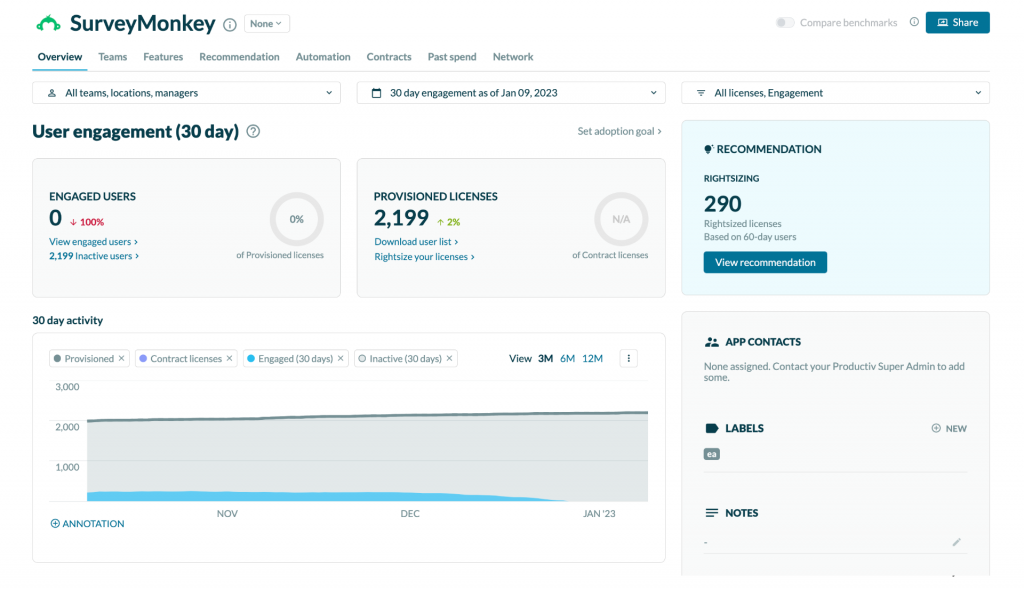
SurveyMonkey is a powerful survey software that simplifies the process of creating and conducting surveys and questionnaires.
It is an ideal tool for conducting surveys and questionnaires for research, feedback, and customer satisfaction. The platform provides a wide range of customizable email survey templates to meet specific needs. I also found a suite of paid programs that include data analysis, sample selection, bias elimination, etc.
In my personal experience, I recommend the software if you are looking for a simple alternative to Google Forms.
What you’ll like:
- Lets you create surveys and forms with AI-powered guidance, logic, and a variety of question types
- Analyzes responses at scale using simple, built-in reports or advanced dashboards
- Uses web links, email, or embeds surveys and forms on your website
- Hundreds of questions across different survey types
- Additional features like IT administration, SSO, user controls, permissions, etc.
What you may not like:
- The pricing can be confusing because of multiple options
- SurveyMonkey’s customer service is ineffective and unhelpful
Pricing: Starts at $25/user/month.
You might also like to read: 15 Best SurveyMonkey Alternatives in 2025
3. Jotform – Best for Creating Online Forms
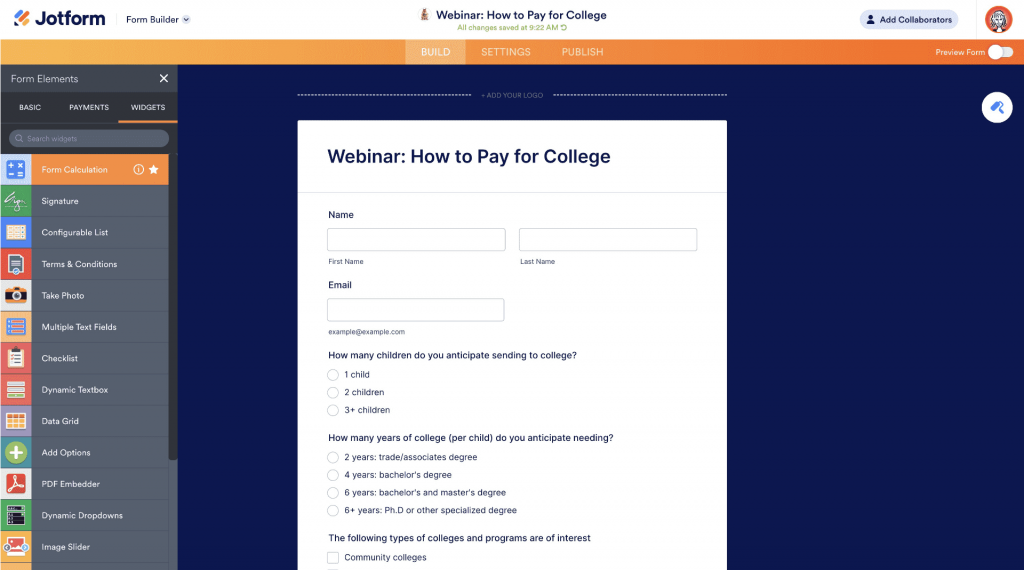
I haven’t had the chance to explore Jotform myself just yet, but a close industry peer recommended it as one of the best email survey tools. First impressions – it seems like the kind of online form builder that takes the hassle out of the process. I’ll tell you in more detail.
With Jotform, you can create forms that use conditional logic, accept payments, generate reports, and automate workflows. Its online form builder allows you to create forms and surveys for free with no coding required.
I also liked its sheer variety of form templates – from simple contact forms to event registrations and complex order sheets.
What you’ll like:
- Automatically sends form submissions to email marketing services, project management boards, CRMs, etc.
- Form translation to reach a broader audience online
- Conditional logic to make your forms smarter
- Lets you add CSS code to your online forms for complete customization
- Allows you to embed e-signature documents into your survey to collect signatures
What you may not like:
- Only 1,000 monthly form views in the free plan can be a limitation for small businesses
- Some users reported that there is no way to create separate links for one form
Pricing: Paid options start from $34/month. A free plan is available for only 5 forms.
Read More: 12 Best Jotform Alternatives & Competitors in 2025
4. SurveyLegend – Best for Mobile-Friendly Surveys

SurveyLegend is an impressive email survey platform that I recently had the opportunity to try out. The tool offers a range of features, including customizable survey designs, drag-and-drop questionnaires, and insightful graphics to display collected data. You can take advantage of white-label questionnaires, skip logic, branching, media-rich questions, etc.
But what I feel sets SurveyLegend apart is its mobile-friendly surveys. The tool has engaging question types, such as media galleries, rating stars, thumbs, sliders, and emojis. These features make surveys come to life on mobile phones, tablets, and computers.
The tool’s real-time analytics feature enables you to make critical, game-changing decisions on the go.
What you’ll like:
- Survey templates for various purposes such as market research, events, politics, etc.
- Mobile-ready surveys that can be accessed from any device
- Customizable design with options to choose typography, fonts, and color schemes
- Geo-location tracking of respondents’ country, city, browser, and OS information
- Real-time analytics to gain actionable insights into survey data
What you may not like:
- You can only have 1,000 responses per survey using the free plan
- White-labeling options are only available in the most expensive plan
Pricing: A free plan is available for only 3 surveys. Paid options start from $15/month.
5. Typeform – Best for Interactive & Conversational Surveys
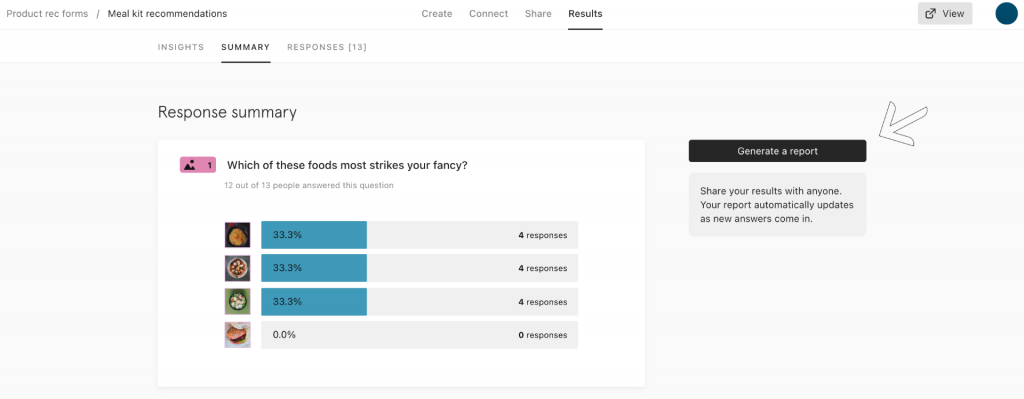
Typeform is a user-friendly online form-building and email survey tool that offers a refreshing take on data collection.
With Typeform, you can create interactive and conversational surveys designed to be refreshingly different. The software’s unique approach to survey design allows you to ask questions one at a time, resulting in more thoughtful responses and higher completion rates.
I used Typeform to create surveys for some research projects and found the platform easy to use. It has a wide range of customizable email survey questions for quizzes, research, feedback, lead generation, etc. The software also offers conditional logic, which allows you to build unique journeys, giving each respondent a personalized experience.
What you’ll like:
- Unrestricted forms and surveys with no limitations on the number of questions or responses
- Answer piping to personalize questions based on previous answers
- A plethora of templates to choose from, including surveys, quizzes, and forms
- Hidden fields to store data that is not visible to users
- Provides 128-bit SSL encryption for secure data transfer
What you may not like:
- Limited reporting options that restrict the types of reports that can be generated
- Some users complain that the software lags with a large number of respondents
Pricing: Starts at $25/month.
Read More: 7 Best Typeform Survey Alternatives & Competitors for 2025
6. Pollfish – Best for Market Research
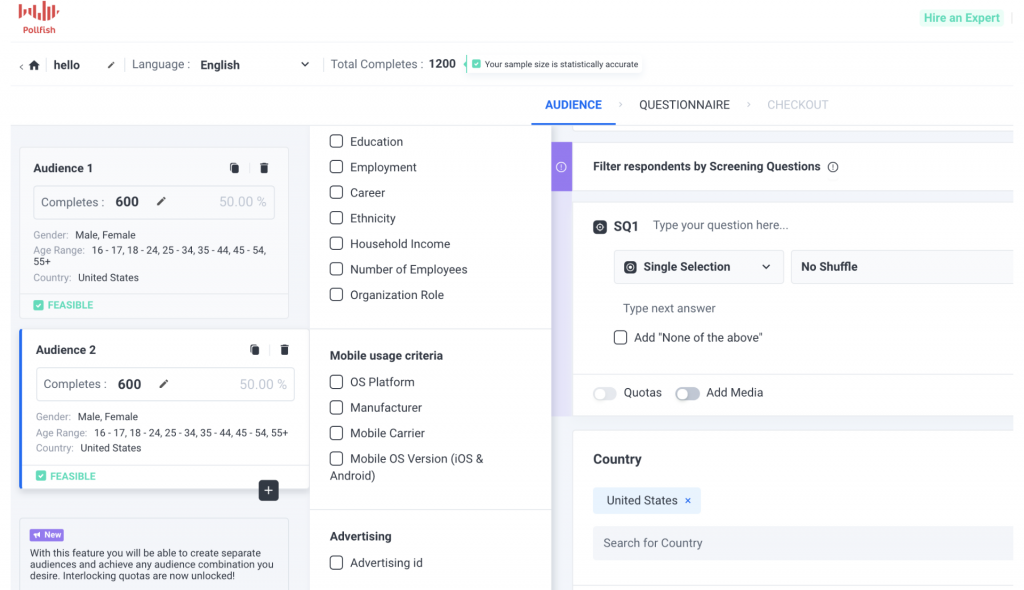
If you want a market research tool that reinvents the way you create email surveys to gather consumer insights, Pollfish can be a good option.
The tool delivers real-time responses, ensuring agility and timely insights for your research endeavors. What I think sets Pollfish apart is its broad distribution network and narrow targeting capabilities. These largely help in reaching the right audience at scale and with speed.
The platform offers AB testing templates, advanced questionnaire logic, and multiple options for conducting market research. In my opinion, it’s ideal for businesses and researchers who seek actionable insights and accurate data.
What you’ll like:
- Enables hyper-targeting of specific audiences
- Granular demographic and psychographic screening and the ability to study various audiences under one survey
- Offers a mobile-first approach to market research
- Advanced survey logic and skip logic for personalized experiences
- Multiple options for conducting market research, including A/B testing, templates, etc.
What you may not like:
- Some users feel that the pricing is high and lacks flexibility
- A few users have reported that the platform’s customer support is not responsive
Pricing: Starts at $1.10/completed survey.
Read More:: 7 Best Pollfish Alternatives for Conducting Surveys in 2025
7. Mopinion – Best for Generating Customer Feedback
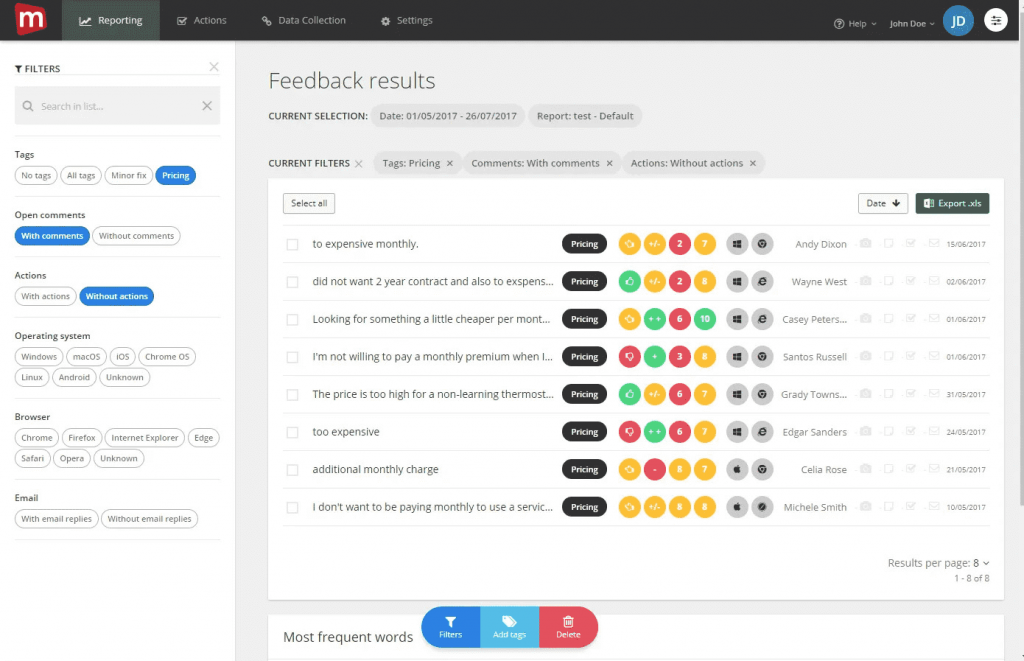
Mopinion is an all-in-one user feedback software that provides actionable insights into the motivation behind customer behavior on digital channels, including emails. It complements quantitative data gathered from email surveys and tells you the story behind it.
The software offers expert-designed forms for every touchpoint, including Customer Satisfaction (CSAT), Goal Completion Rate (GCR), and Net Promoter Score (NPS). It is designed to help digital-first enterprises take control of the entire online journey.
I had a great experience using Mopinion. The tool is easy to use and provides a fresh perspective on every customer’s online journey. I particularly liked the flexibility of the email feedback forms and the ability to design my own surveys from scratch.
What you’ll like:
- Feedback collection across all channels – website, in-app, and email campaigns
- Customizable feedback forms with various CX metrics such as NPS, CES, and CSAT
- Variety of display options for feedback forms – modal, embedded, conversational, etc.
- Complex question routing to show or hide feedback questions based on user input
- Rule-based form triggering to ask questions on specific pages based on user data
What you may not like:
- Some users reported that the tool is difficult to set up
- The software is expensive for small businesses
Pricing: Starts at $259/month.
Read More: 15 Best Mopinion Alternatives for Businesses to Collect Customer Insights
8. HubSpot – Best for Analyzing Customer Feedback

I think HubSpot has one of the best email survey tools designed to scale alongside your business. The software lets you create custom surveys with a wide range of survey email examples and a customizable template.
You can send surveys via web link or email, then efficiently share insights with teams to deepen customer relationships and improve retention. The software also offers pre-built net promoter score (NPS), customer effort score (CES), and customer satisfaction (CSAT) surveys to gauge customer loyalty at every touch point.
HubSpot’s built-in feedback dashboards help you monitor customer satisfaction closely and take immediate action on gathered insights. This helps uncover growth opportunities and improve the customer journey.
What you’ll like:
- Customizable surveys with a wide range of question types and templates
- Pre-built surveys like NPS and CSAT to gauge customer loyalty
- Built-in feedback dashboards for monitoring customer happiness
- Automated survey sending and data collection
- Trend identification for creating effective customer service strategies
What you may not like:
- Lack of advanced reporting features and data visualization
- Difficulty in analyzing large volumes of feedback data
Pricing: Paid options start from $18/month. A free plan is available for only up to 3 dashboards.
9. Qualtrics – Best for Enterprise-Level Surveys
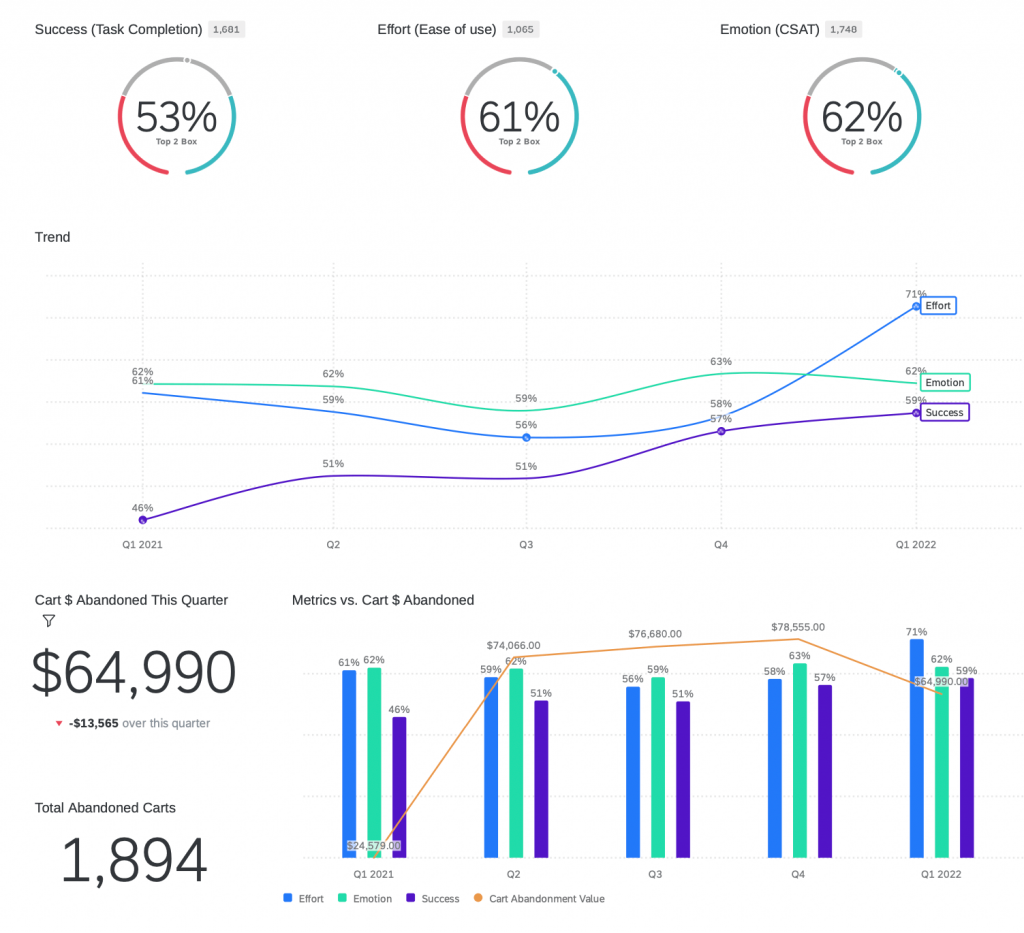
Qualtrics is a customer experience management (CXM) platform that helps you organize and evaluate important data related to customers. It is an enterprise-level survey software designed to be shared across large and complex organizational structures with powerful analytics capabilities.
Using the software, I could supercharge email conversion rates, optimize digital self-service, uncover insights from email interactions, and more.
The software comes equipped with advanced features like branching, display logic, and automatic score calculation for your email surveys. It’s easy to use, customizable, and loaded with a wide range of question types.
What you’ll like:
- Expert-designed templates that cater to different industries and use cases
- Automated XM Solutions that help you take action on feedback in real time
- Customizable survey themes that can be tailored to your brand
- Advanced survey logic that allows you to create complex surveys
- Quota management to ensure that you get the right number of responses
What you may not like:
- Pricing is not transparent, which can make getting a quote time-consuming
- Bugs and occasional glitches that can make it difficult to use
Pricing: Starts at $1500/year (estimated pricing). Contact Qualtrics for a custom quote.
Read More: 11 Best Qualtrics Alternatives & Competitors in 2025
10. Zonka Feedback – Best for NPS Surveys
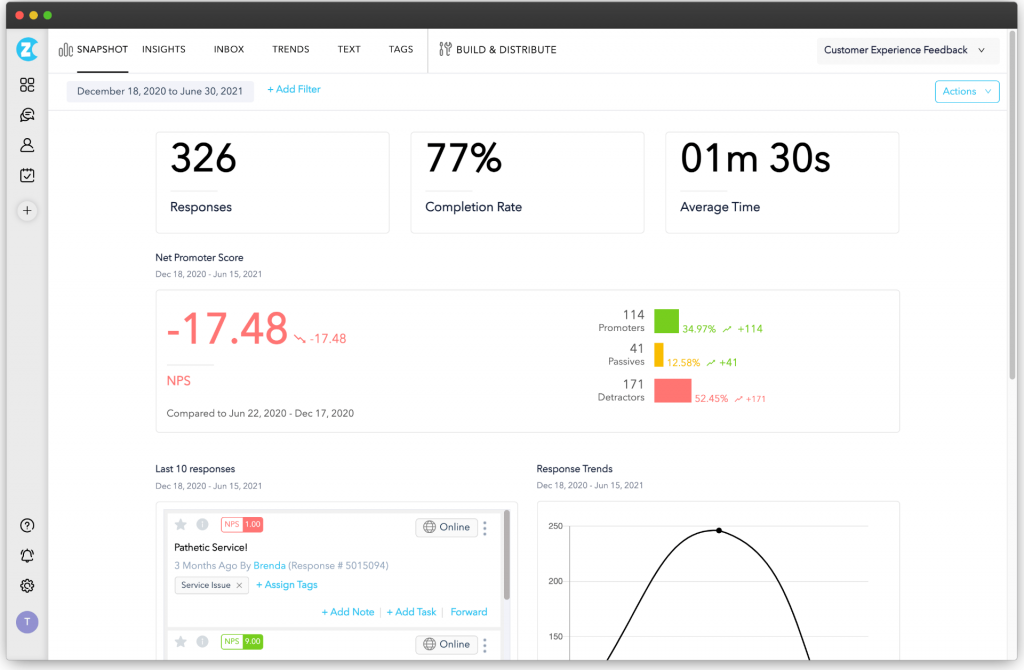
Zonka Feedback stands out in its ability to measure Net Promoter Score (NPS), a key metric for gauging customer loyalty and satisfaction.
The tool lets you easily create and distribute NPS questionnaires through emails, track scores, and generate detailed reports. The platform’s advanced analytics provide a clear understanding of customer sentiment, enabling you to enhance customer loyalty.
Apart from that, the tool offers a range of features, including customized surveys and feedback forms for emails, offline surveys, and website feedback capture. I found the platform to be intuitive and user-friendly, with a flexible what-you-see-is-what-you-get (WYSIWYG) editor for creating engaging surveys.
What you’ll like:
- Net Promoter Score (NPS) for customer loyalty measurement
- Automates CX workflows to streamline customer experience
- Access to in-depth feedback data and survey reports
- Offline kiosk surveys on iOS and Android
- Connects with multiple tools through APIs and integrations
What you may not like:
- The platform can be slow to load at times
- Lacks essential features such as file upload, location-based surveys, offline surveys, etc. in the free plan
Pricing: Paid options start from $49/month. A free plan is available with a limited number of questions per survey.
Evaluation Criteria
The evaluation of products or tools chosen for this article follows an unbiased, systematic approach that ensures a fair, insightful, and well-rounded review. This method employs six key factors:
- User Reviews / Ratings: Direct experiences from users, including ratings and feedback from reputable sites, provide a ground-level perspective. This feedback is critical in understanding overall satisfaction and potential problems.
- Essential Features & Functionality: The value of a product is ascertained by its core features and overall functionality. Through an in-depth exploration of these aspects, the practical usefulness and effectiveness of the tools are carefully evaluated.
- Ease of Use: The user-friendliness of a product or service is assessed, focusing on the design, interface, and navigation. This ensures a positive experience for users of all levels of expertise.
- Customer Support: The quality of customer support is examined, taking into account its efficiency and how well it supports users in different phases – setting up, addressing concerns, and resolving operational issues.
- Value for Money: Value for money is evaluated by comparing the quality, performance, and features. The goal is to help the reader understand whether they would be getting their money’s worth.
- Personal Experience / Expert’s Opinion or Favorites: This part of the evaluation criteria draws insightful observations from the personal experience of the writer and the opinions of industry experts.
Which Is the Best Email Survey Software for You?
Out of the tons of email survey tools you may find in the market, these are some of the most chosen ones. But to answer which one among these is the best for your company – well, it can be a tough call.
To find that, you need to evaluate your requirements first. But if you need a little help from me, I can pick my top three choices for you. Check them below –
Option A: Qualaroo
For over a year, I’ve relied on Qualaroo as my primary email survey tool. Its sentiment analysis, powered by IBM Watson, efficiently transforms free-form text into organized data. Qualaroo allows you to create surveys that you can send as links in your email or use its ProProfs Survey Maker tool for email embed surveys.
Option B: SurveyLegend
SurveyLegend stands out with customizable designs, drag-and-drop questionnaires, and engaging graphics. What sets it apart is its mobile-friendly surveys with interactive question types like media galleries and emojis, making it vibrant on various devices.
Option C: Typeform
Typeform is a user-friendly email survey tool with a unique one-question-at-a-time approach, fostering thoughtful responses. It’s versatile for various purposes, offering customizable questions, conditional logic, and easy usability for quizzes, research, and feedback.
Frequently Asked Questions
Can you send a survey via email?
Yes, you can either send a survey as a link on the email or use a tool like Qualaroo to embed surveys in your email.
Are email surveys good?
Email surveys can be an effective tool for gathering feedback and insights from your audience. They provide higher response rates than most other survey methods and require minimum resources. With email surveys, you can add a message and let respondents know more about the data collection.
What is the difference between a web survey and an email survey?
A web survey is typically conducted on a website or a dedicated survey platform. In contrast, an email survey is distributed via email to participants, who then respond directly to the email or by clicking a link to an online survey.
 Tips
Tips
We’d love to hear your tips & suggestions on this article!
FREE. All Features. FOREVER!
Try our Forever FREE account with all premium features!

 We'd love your feedback!
We'd love your feedback! Thanks for your feedback!
Thanks for your feedback!

